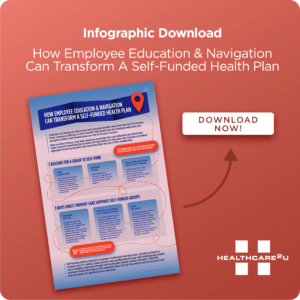A recent Gallup poll found that less than half of Americans are satisfied with the quality of US healthcare, the lowest in twenty years. Other studies and polls have identified unaffordable care, poor access to care, and lack of coordinated care as Americans’ main areas of contention. Fortunately, some companies provide solutions in the form of benefit offerings that leverage technology to drive change, automate, simplify, and streamline the patient’s experience.
Healthcare When and Where You Need It
Access to affordable and timely care is essential to good overall health. Still, many Americans are delaying medical care due to costs or are unable to physically meet with a doctor due to distance, transportation issues, or limited appointments.
Most healthcare providers are meeting the need for accessible healthcare by offering virtual care and telehealth options. Fueled by the pandemic, remote care options have seen rapid technological advancements. This will continue to improve in the coming years. Some providers are expanding remote care to include AI-powered digital health offerings like chatbots, symptom checkers, and resource libraries for physicians.
These digital health offerings provide remote access to healthcare services, allowing patients to quickly receive medical care and consultations from the comfort of their own homes. This access can be particularly beneficial for patients with limited mobility who live in rural areas or face other barriers to accessing healthcare. While each provider has varying interfaces and processes, the core of remote care and digital health offerings is ease of use and accessibility. By simplifying the process of seeking out and obtaining care, patients are encouraged and empowered to address health concerns sooner rather than later.
Gaps in Care Coordination
Another important component of an excellent patient experience is how care coordination is handled. Unfortunately, only half of US primary care physicians reported sufficient coordination with other providers. Fewer than half are notified when another provider modifies a patient’s care plan or medication regimen. This lack of coordinated care is concerning because it can result in increased healthcare costs, decreased patient satisfaction, and reduced quality of care. This oversight presents an opportunity zone where technology can contribute to a better patient experience by simplifying the process of sharing health records.
Electronic Health Records (EHR) were created to help physicians capture a full profile of patient data that can be transferred between physicians. However, EHRs are not standardized and vary by region, hospital, and system provider so there are still many interoperability issues. Fortunately, these issues have been recognized, so we should see further developments. To fill this gap, many benefit offerings incorporate patient navigation services to coordinate care, while others have developed their own systems for storing patient records.
Deliver Concierge-Level Patient Experience with a Direct Primary Care Membership
Direct Primary Care (DPC) is a monthly membership that provides affordable and convenient access to excellent primary medical care, wellness, and chronic disease management for a low monthly fee. Patient experience is at the core of DPC, making it an ideal option for employers looking to provide valuable and accessible employee benefits. The DPC model prioritizes patient-centered care by offering flexible scheduling options, longer appointment times, and transparent pricing. This type of unrestrictive access to a physician can improve health outcomes and strengthen the doctor-patient relationship. DPC especially benefits those with early-stage chronic conditions requiring frequent primary care visits.
Not all DPC memberships are the same – access, price, and services can all vary by practice. Most DPC practices are regional-based and contract directly with individuals in their area, which limits DPC’s benefits to one location. Patients from rural areas or who travel frequently may struggle with regional-based DPC practices. Additionally, the practice sets pricing and services, so those looking for affordable options may have difficulty finding a DPC practice nearby that fits their budget. For employers who want a DPC solution available in different regions, a nationwide DPC membership would best serve their employees.
Healthcare2U: A Nationwide Solution for Direct Primary Care
Healthcare2U’s Direct Primary Care membership removes the barriers to care by providing members with unlimited nationwide access to affordable care. This includes appointments virtually or in-office, unlimited treatment and management of chronic diseases, and round-the-clock virtual care. As mentioned earlier, Healthcare2U also includes patient navigation and advocacy, ensuring members have a bilingual certified medical professional to guide them through their benefits, care options, and appointments. We also built an internal record system to capture patient data that can be shared seamlessly with our Private Physician Network™, meaning that our members have nationwide access to their health information.
Our unique combination of technology and primary care benefits provides concierge-level patient experiences that are easy from beginning to end. We work with brokers nationwide to eliminate barriers to care and encourage patient-physician relationships. Contact us for more information about how DPC can provide concierge-level patient experiences for employer groups.

